Training Day
Today was training day for the snake rescue volunteers at the Wildlife Center of New Mexico. As usual, head-of-the-reptile-rescue-program Tom Wyant brought a few of his critters along for the show.
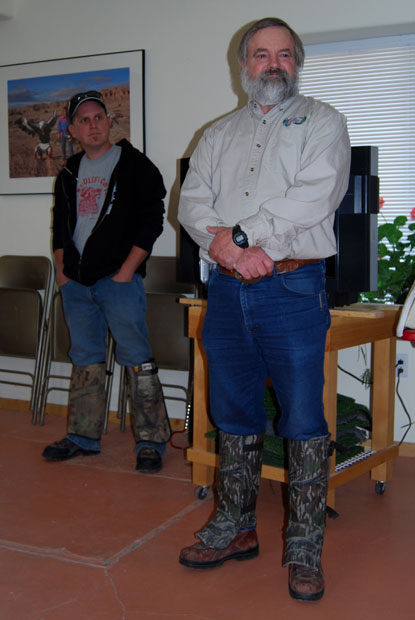
Here's Tom Wyant (front) and C.J. Carmen, our instructors for the clinic. They're my herping gurus. Both have many years experience with reptiles in New Mexico. Tom particularly enjoys finding caves full of rattlesnakes. He also gets employed as a snake wrangler for movie productions in the state.
C.J. is a veritable encyclopedia of snake information. I often find myself corrected by him, which is always a welcome thing as it only sharpens my knowledge on the subject.
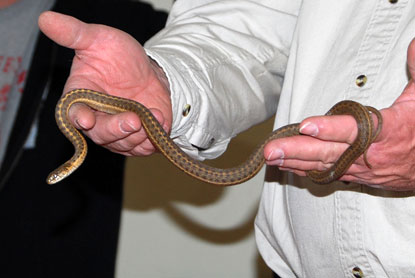
Tom's terrestrial garter snake (Thamnophis elegans), named Stinky. All of these snakes have names, but I only remembered this one's.
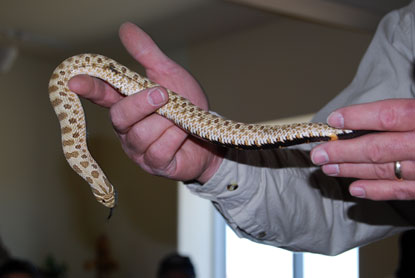
A western hog nose snake (Heterodon nasicus). These things are adorable. They are venomous and rear-fanged, but also cute and cuddly and quite friendly. But if you find one in the wild, get ready for one of the greatest bluff shows on Earth.
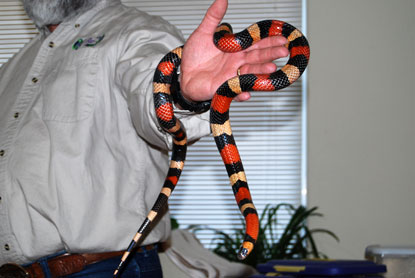
This is a pueblo milk snake (Lampropeltis triangulum campbelli), native to Mexico and central America, but not New Mexico.

Another non-native species, a common corn snake (Elaphe guttata guttata).
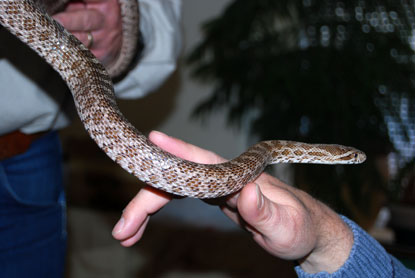
A great plains rat snake (Elaphe guttata emoryi). This is our native corn snake. It has doubled in size since I saw him last year.
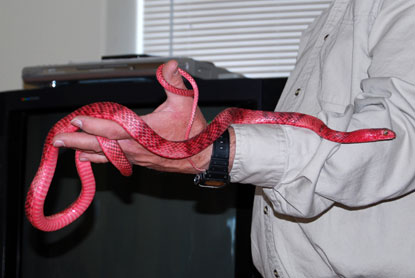
Tom's coachwhip snake (Masticophis flagellum) is the tamest and reddest I've ever seen. Corner one of these in the wild and they'll be all up in your face... literally. I've been jumped by three at once while lifting the board they were under, missing taking a direct strike in the face by millimeters.
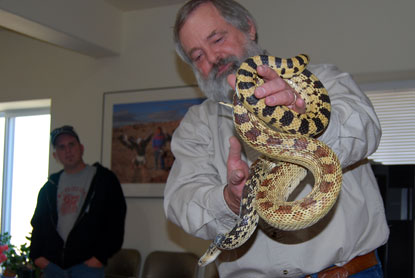
The very common gopher, or bull snake (Pituophis catenifer). Often mistaken for a rattlesnake and killed, they are very valuable as rodent controllers in a state where we can contract two very deadly rodent-borne diseases, Hanta virus and Bubonic plague.
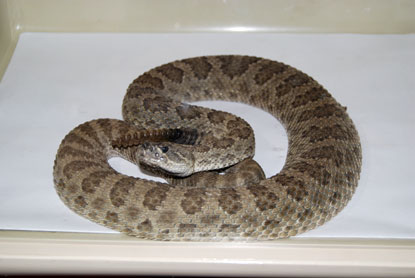
Our most common local rattlesnake, the prairie rattlesnake (Crotalus viridis viridis).
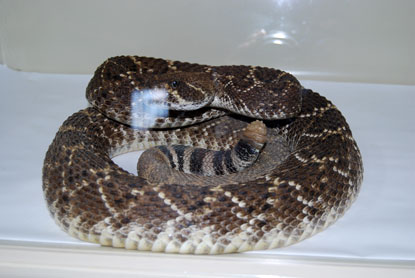
Not quite so common locally, but very common in other parts of the state, the western diamondback rattlesnake (Crotalus atrox).
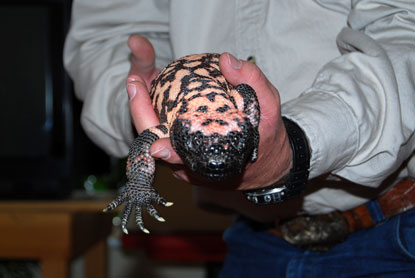
Tom whips out the Gila monster (Heloderma suspectum). His permit to keep it requires him to show it at demonstration events 12 times a year. It's on the endangered species list and will land you in jail if you are caught with one sans permit. By the way, it's very poisonous, but usually not deadly.

C.J. shows us how to identify snake sheds. The key is in the caudal scales, posterior to the cloaca (anal vent). Split caudals indicate a nonvenomous species in New Mexico. Solid caudals, especially on a big shed, mean rattlesnake. There is one exception to this rule here. Garter snakes have solid caudal scales as well.
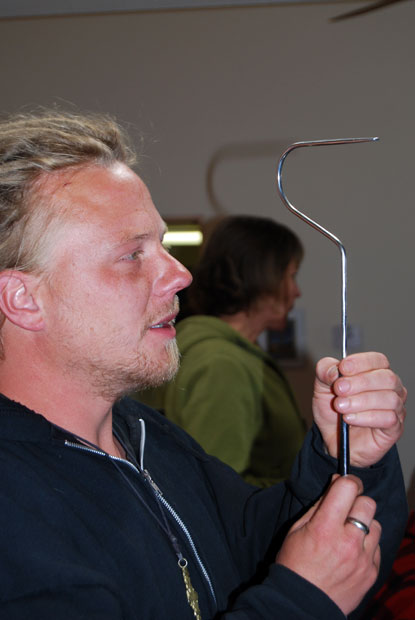
Volunteer Christian inspects his new snake hook, built and provided by Tom.
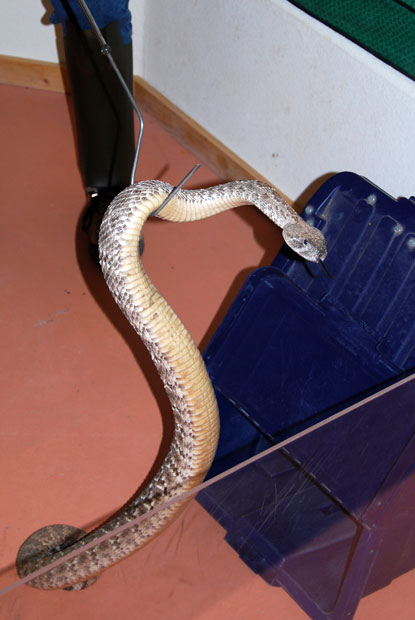
A volunteer works with a good-sized western diamondback.
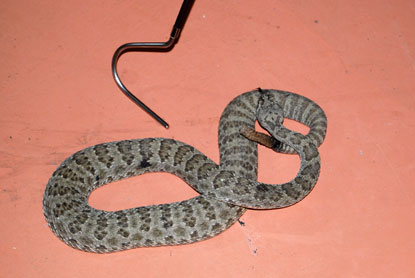
A prairie rattlesnake about to get the hook from a volunteer practicing snake rescue skills.
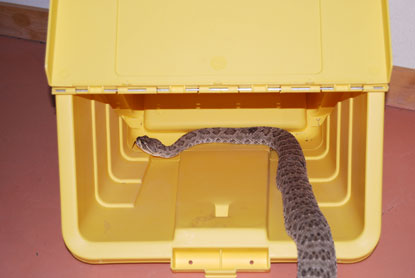
The prairie rattlesnake cooperating in his "capture."
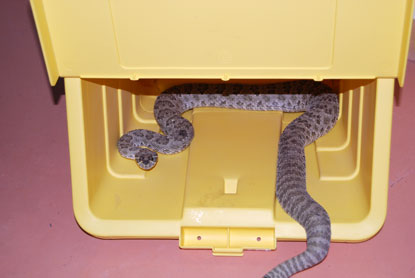
But not always...
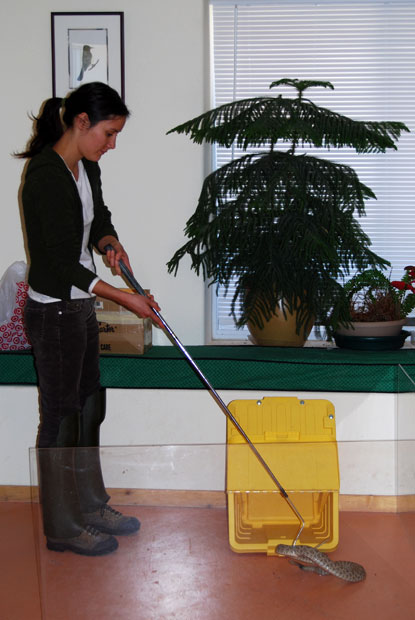
Volunteer Pilar shows us how it's done.
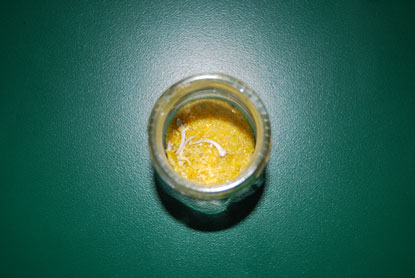
This is what you've got to worry about when handling rattlesnakes. Just ask C.J. He's been bitten four times.

8 Comments:
This is a terrific site - glad you've created it. I'm relatively new to New Mexico and have some property in Cerrillos where I saw what I believe to be a young bull snake today. It was at most 2ft in lengh and rather narrow - no rattle and the head was small and oval-ish, body golden-yellow background. Last September, I also saw a hot-pink snake about 3ft long in the middle of Goldmine Rd in Cerrillos. Amazing color and very fast. Question: if there is a small/young bull snake around, would that mean there are others? I'm glad to have them....thanks, Lisa
Bull snakes are very common in this area. I found a dead one on Old Las Vegas highway this morning. It's likely there are others depending on how plentiful the food sources are. Bull snakes are primarily rodent eaters.
The hot pink snake was a western coachwhip, also fairly common to most of northern New Mexico.
just encountered a beautiful gopher or bull snake in Eldorado, Santa Fe Nm. Lying in the road basking in the afternoon sun. Hope everyone who lives off encantado loop realizes he is a helper snake and doesnt run over him or even worse kill him.
I hike the westside of the sandias regularly, and routinely move snakes off the road around tramway... My question is i came across this 6 foot snake completely olive except for 5 inches from the head was pink. It was very fast and went up a tree, could this have been a coachwhip
I'm so glad to see your picture of a bright pink coachwhip, as I saw one on a neighborhood street in Rio Rancho a few years ago. At first I thought it was something like a tie belt off a robe lying in the middle of the street, which was odd, but when it started to slither away that was odder yet. Through a little research I learned it was a coachwhip but this is the first time I've ever found a picture like the snake I saw. Great site, thanks - Margie
[url=http://vioperdosas.net/][img]http://sapresodas.net/img-add/euro2.jpg[/img][/url]
[b]office software to buy, [url=http://vioperdosas.net/]office 2003 cd key[/url]
[url=http://sapresodas.net/]software stores montreal[/url] buy macromedia suite educational software companies
winzip 12 regcode [url=http://sapresodas.net/]mobile educational software[/url] discount office software
[url=http://vioperdosas.net/]macromedia com software flash fl4about[/url] discounted computer software for
[url=http://sapresodas.net/]kaspersky internet security 2009 reviews[/url] adobe acrobat 9 key torrent
cheap cs3 software [url=http://vioperdosas.net/]CS4 Extended Mac Retail[/url][/b]
Nice pics of the snakes, especially the Red Coachwhip. Being a Native of Florida from the 60s & 70s era, I can relate to being "assaulted"(LOL) by Eastern Coachwhip Snakes while out herping. I even used to watch them hunt for birds and race-runner lizards. Really impressive.
Joseph (USAF/Ret.)
Post a Comment
<< Home